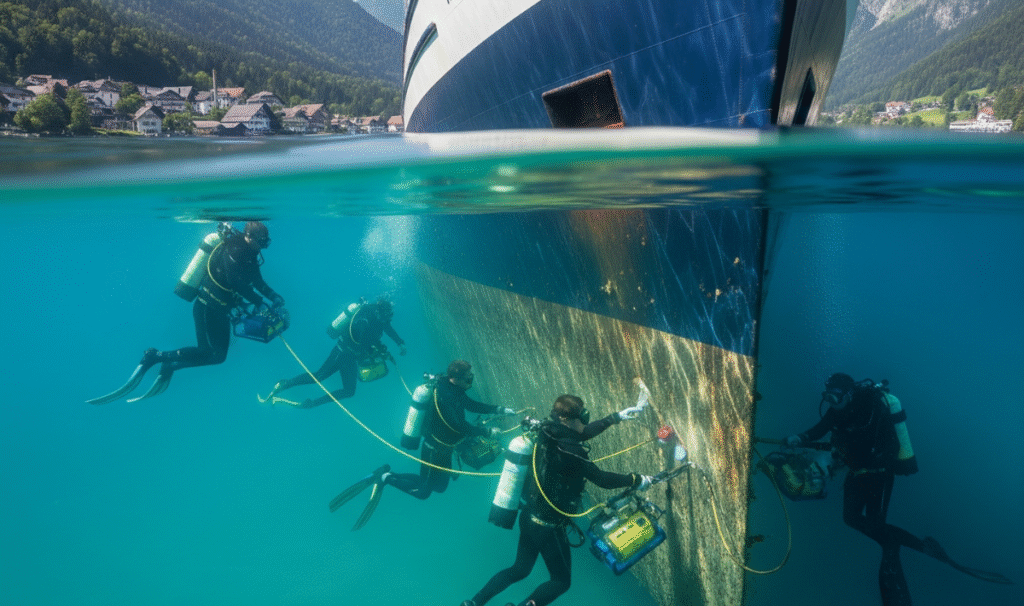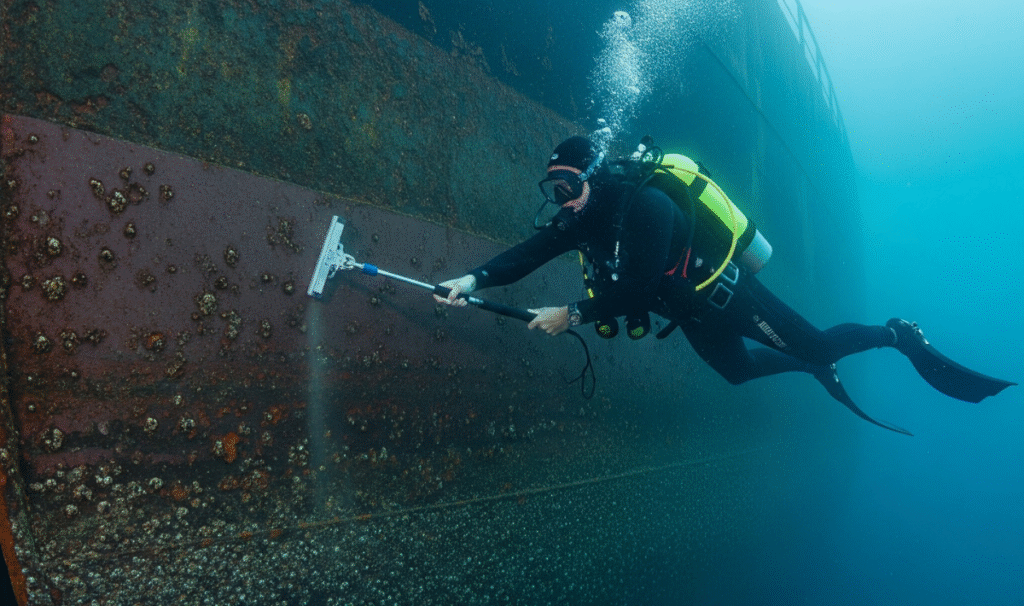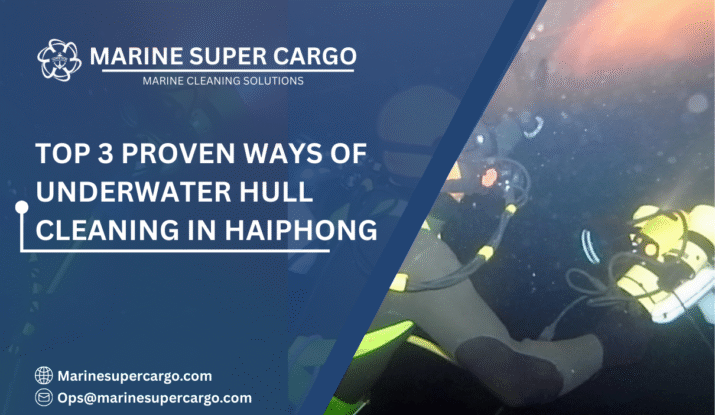Your vessel frequents the bustling port city of Haiphong. Underwater hull cleaning in Haiphong is more than routine maintenance—it’s a strategic necessity to preserve vessel efficiency, reduce fuel costs, and comply with environmental regulations. Think of your hull as a finely tuned blade slicing through water. When fouled with barnacles, algae, and marine growth, it transforms into a dull paddle pushing through thick mud. Let’s dive into why regular underwater hull cleaning in Haiphong is critical, how it’s expertly executed, and how to select the right service provider for your vessel.
Why Underwater Hull Cleaning in Haiphong is Essential
Haiphong’s warm, nutrient-rich waters provide ideal conditions for rapid biofouling, including barnacles, tube worms, and algae that quickly attach to submerged surfaces. This fouling increases hydrodynamic drag, forcing engines to burn more fuel and slowing vessel speeds. Beyond performance impacts, fouling damages protective hull coatings and accelerates corrosion, leading to costly repairs and downtime. Furthermore, Haiphong’s stringent environmental protocols require vessels to maintain clean hulls to prevent the spread of invasive species and meet international standards.
Haiphong’s Marine Environment and Fouling Challenges
Situated on the Gulf of Tonkin, Haiphong’s coastal waters combine tropical temperatures, tidal currents, and brackish water from river systems. This environment promotes diverse and fast-growing fouling communities. Ships often accumulate significant fouling during idling or slow-moving periods, especially in sheltered bays and harbor zones. Fouling rates fluctuate seasonally, with warmer months accelerating growth, requiring vessel operators to adapt cleaning schedules accordingly.

Consequences of Neglecting Underwater Hull Cleaning in Haiphong Waters
Ignoring Underwater Hull Cleaning in Haiphong Leads to:
- Substantial fuel consumption increases by up to 20%
- Noticeable speed and handling reductions
- Accelerated wear and coating degradation
- Blockage of water intakes, propellers, and sensors
- Non-compliance penalties and potential port access restrictions
- Unexpected costly repairs and operational delays
These consequences not only hurt operational efficiency but also violate international maritime regulations. Regular maintenance aligned with the International Maritime Organization (IMO) biofouling guidelines helps ensure legal compliance and protects marine ecosystems.
The Step-by-Step Process of Underwater Hull Cleaning in Haiphong
Dive Preparation and Safety Protocols
Qualified diving teams begin with site assessment—checking tides, currents, water clarity, and vessel conditions. Safety checks, communication setup, and coordination with port authorities ensure the dive proceeds incident-free amidst Haiphong’s busy shipping lanes.
Tools, Technology, and Techniques Used in Haiphong
Cleaning experts utilize rotary brushes and hydraulic scrapers designed to remove fouling effectively without damaging hull coatings. Non-abrasive pads address delicate surfaces. Underwater cameras and remotely operated vehicles (ROVs) document the cleaning process and verify thoroughness. Debris containment and filtration systems prevent environmental contamination, aligned with local and international standards.
How to Choose a Reliable Underwater Hull Cleaning Service in Haiphong
Certifications, Experience, and Local Expertise
Choose companies offering:
Certified commercial divers with extensive experience in Haiphong waters
Compliance with Vietnamese and IMO environmental standards
Transparent reporting with inspection photos and documentation
Prompt, professional service with proven track records in busy port environments
Recommended Cleaning Frequency for Vessels in Haiphong
Given the rapid biofouling growth, vessels benefit from hull cleaning every 1 to 3 months, with schedules adjusted for vessel activity, coating type, and season.
Environmental Regulations and Sustainable Cleaning Practices
Haiphong enforces stringent environmental and biosecurity measures, requiring:
Eco-friendly cleaning agents and low-impact techniques
Full capture and responsible disposal of fouling waste
Immediate reporting of invasive species to local authorities
Minimal disruption to surrounding marine ecosystems during operations
These practices align with global sustainability standards promoted by the International Association of Ports and Harbors (IAPH).
Cost Expectations for Underwater Hull Cleaning in Haiphong
Typical costs range from USD 6 to 12 per foot of hull cleaned, influenced by vessel size, fouling severity, and any additional services such as propeller polishing or detailed inspections. Investing in regular cleaning reduces fuel and maintenance expenses significantly.
DIY vs. Professional Hull Cleaning: Pros and Cons
DIY cleaning may seem cost-effective but presents risks, including diver safety hazards, potential hull damage, non-compliance with environmental rules, and a lack of professional documentation. Certified professional services ensure thorough, safe cleaning, legal compliance, and valuable inspection records.
Benefits of Regular Underwater Hull Cleaning in Haiphong: Efficiency, Longevity, and Compliance
Consistent hull maintenance offers major benefits:
Up to 20% savings on fuel consumption by reducing drag
Improved speed, handling, and maneuverability, especially during critical operations
Extended life of hull coatings, reduced corrosion, and fewer repainting cycles
Faster, smoother port inspections with less risk of detention or fines
Early detection of mechanical damage to shafts, propellers, or sea chests—saving costly repairs
Regular cleaning also supports compliance with international standards MARPOL Annex V, which regulates marine pollution from ships.

Real Experiences from Haiphong Mariners
Boat operators around Haiphong report improved fuel efficiency, fewer mechanical breakdowns, and smoother operations after adopting regular professional underwater hull cleaning services. Many emphasize how compliance documentation facilitates swift port entry and insurance claims. One cargo ship captain noted a 15% reduction in bunker fuel usage post-cleaning, while a local tugboat operator avoided propeller entanglement thanks to early detection during an inspection dive. These real-world results underline the operational and financial value of routine maintenance in Haiphong’s dynamic maritime environment.
Conclusion:
Underwater hull cleaning in Haiphong is a key operational practice safeguarding your vessel’s performance, fuel budget, and legal standing. Partnering with certified, experienced professionals who understand local conditions ensures a clean hull, smoother sails, and a clearer conscience regarding environmental impact. Glide through Haiphong’s waterways with confidence, speed, and sustainability.
FAQ:
Q1. How often should underwater hull cleaning be scheduled in Haiphong?
Typically, every 1 to 3 months, depending on fouling rates, vessel type, and operational patterns.
Q2. Are hull cleaning methods environmentally safe in Haiphong?
Yes, services follow eco-friendly methods with debris containment to comply with local and international regulations.
Q3. What are the typical costs for underwater hull cleaning in Haiphong?
Costs generally range between USD 6 and 12 per foot, varying with vessel size and fouling degree.
Q4. Can I clean my hull myself underwater in Haiphong?
DIY cleaning is not recommended due to safety risks, environmental concerns, and regulatory requirements; professional services are advisable.
Q5. What benefits does regular hull cleaning provide?
Reduced fuel consumption, improved vessel speed, extended hull coating life, fewer maintenance issues, and regulatory compliance.


